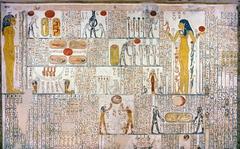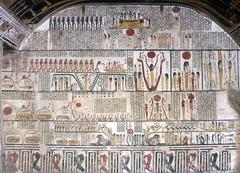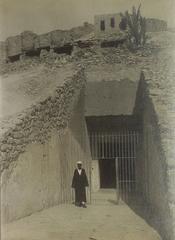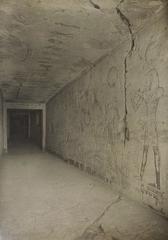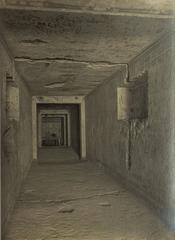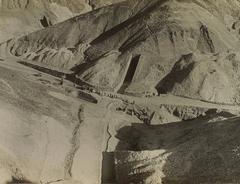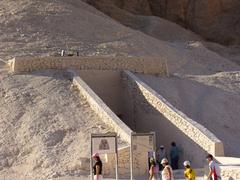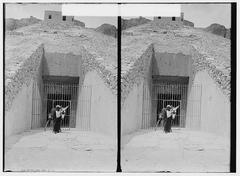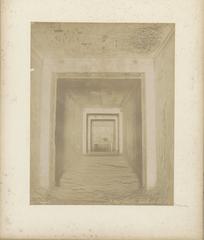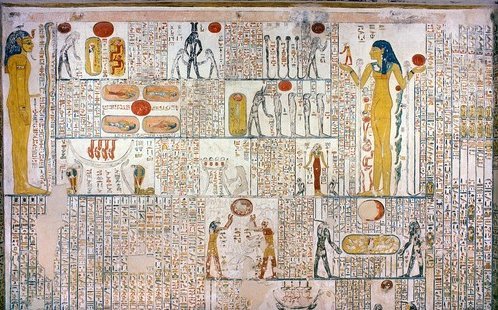
KV9 Luxor: Visiting Hours, Tickets, and Historical Significance – Comprehensive Guide
Date: 14/06/2025
Introduction
Located in the legendary Valley of the Kings near Luxor, the tomb known as KV9 stands as a monumental testament to the grandeur and complexity of ancient Egyptian royal funerary traditions. Serving as the final resting place for Pharaohs Ramesses V and Ramesses VI of the Twentieth Dynasty, KV9 is celebrated for its remarkable length, intricate architectural design, and exceptionally preserved wall paintings depicting key funerary texts. These decorations, including scenes from the Book of Gates, the Book of the Earth, and the Amduat, offer profound insights into ancient Egyptian beliefs about death, divinity, and the afterlife.
For visitors, KV9 offers more than just a glimpse into antiquity; it is a journey through a subterranean necropolis and a layered historical narrative shaped by political turbulence and dynastic assertion. This detailed guide provides everything you need to plan your visit—from up-to-date information on visiting hours, ticketing, and accessibility to in-depth explorations of KV9’s architecture, art, and ongoing conservation efforts. Whether you are a history enthusiast, an admirer of Egyptian art, or an adventurous traveler, KV9 promises an unforgettable experience.
For the latest official information, consult resources such as the Madain Project, Egyptian Ministry of Tourism, and Lonely Planet.
Contents
- Introduction
- Origins and Construction of KV9
- Historical and Political Context
- Architectural Features and Innovations
- Decorative Program and Religious Significance
- Visiting KV9: Hours, Tickets, and Tips
- Accessibility and Visitor Experience
- Conservation Challenges and Ongoing Preservation
- Nearby Attractions
- Frequently Asked Questions (FAQs)
- Visual and Media Resources
- Conclusion and Recommendations
- Sources and Further Reading
Origins and Construction of KV9
KV9 was originally commissioned for Pharaoh Ramesses V (reigned 1147–1143 BCE) of Egypt’s Twentieth Dynasty. After his death, his uncle and successor, Ramesses VI (reigned 1143–1136 BCE), expanded and richly decorated the tomb, making it one of the valley’s largest and most elaborate burial sites (Madain Project; Wikipedia).
Stretching approximately 117 meters, KV9 features a series of gently sloping corridors and chambers, culminating in a grand burial chamber adorned with celestial iconography and intricate reliefs typical of the Ramesside period (Lonely Planet). Its expansion under Ramesses VI reflects both practical reuse and dynastic symbolism.
Historical and Political Context
The construction and later expansion of KV9 took place during a period of political decline and economic instability in Egypt’s Twentieth Dynasty. Ramesses V’s short reign was marked by plagues and administrative challenges. Ramesses VI, seeking to consolidate his rule, appropriated his predecessor’s tomb, reinforcing his dynastic ties and divine authority through elaborate decoration and religious iconography (The Brain Chamber).
Architectural Features and Innovations
KV9 adheres to the classic New Kingdom royal tomb design but distinguishes itself with its scale and complexity. Broad corridors, spacious chambers, and a straight-axis descent reflect the importance of its occupants. During construction, workers accidentally broke into the neighboring tomb KV12, a testament to the density of tombs in the Valley (Wikipedia).
The burial chamber contains an unfinished pit—likely intended for the king’s sarcophagus—and the original sarcophagus lid’s face is housed in the British Museum, with a replica on display in the tomb (Madain Project).
Decorative Program and Religious Significance
KV9 is renowned for its vibrant and well-preserved decorations. Nearly every surface is adorned with scenes from prominent funerary texts:
- The Book of Gates
- The Book of the Earth
- The Book of Caverns
- The Amduat
- The Book of the Dead
The astronomical ceiling in the burial chamber, depicting the goddess Nut and the sun’s nightly journey, is a highlight, symbolizing regeneration and eternal life (Egypt for Travel). Ramesses VI’s additions draw inspiration from the Osireion at Abydos, further emphasizing the king’s association with Osiris, god of the afterlife (Wikipedia).
Visiting KV9: Hours, Tickets, and Tips
Visiting Hours
- General Schedule: Daily, 6:00 AM – 5:00 PM (last entry typically one hour before closing)
- Seasonal Variations: Hours may change during holidays or summer months; always check official sources before your visit.
Ticketing and Entry Fees
- General Valley of the Kings Ticket: 600 EGP for adults (includes entry to three tombs, excluding KV9 and select others)
- KV9 Supplementary Ticket: 220 EGP for adults, 60 EGP for students (with valid ID), 30 EGP for Egyptian/Arab adults, 10 EGP for Egyptian/Arab students (Earth Trekkers; Egypt Tour Packages)
- Camera Ticket: 300 EGP for photography privileges inside the tomb; flash is strictly prohibited (ETL Travel)
- Luxor Pass: Offers combined entry to KV9 and other premium sites (Explore Luxor)
Best Time to Visit
- Peak Hours: 9:00 AM – 12:00 PM (October–April)
- Recommended: Arrive at opening (6:00 AM) or after 2:00 PM to avoid crowds and midday heat.
How to Get There
- KV9 is accessible via taxi, private car, or organized tour from Luxor. Electric trains (Taftaf) shuttle visitors from the entrance to the tomb cluster for a small fee (ETL Travel).
Accessibility and Visitor Experience
Physical Accessibility
- Ground-level entrance with a gently sloping, straight-axis corridor.
- No major stairs, but uneven and sometimes slippery flooring. Not fully wheelchair accessible, but easier to navigate than some other tombs (ETB Tours Egypt).
Lighting
- Electric lighting enhances visibility of artwork and details.
Visitor Conduct and Regulations
- Do not touch walls or artwork.
- Large bags may be restricted; lockers are available.
- Smoking, eating, and drinking prohibited inside the tomb.
- Respect photography restrictions.
Guided Tours
- Licensed guides are available at the visitor center and through tour operators. A guide is recommended for historical context and interpretation.
Conservation Challenges and Ongoing Preservation
Environmental Threats
KV9 faces threats from extreme temperature shifts, humidity, and flash flooding, all of which can damage the tomb’s structure and artwork. Visitor breath and high humidity encourage fungal growth and salt crystallization, endangering pigments (egyptdesertdunes.com).
Impact of Tourism
High visitor numbers increase carbon dioxide and moisture, destabilizing the tomb’s microclimate. Ticketing limits and rotating tomb openings help mitigate this (thetravel.com).
Structural Conservation
Engineers monitor and reinforce the tomb’s structure, especially unfinished and vulnerable areas. Improved drainage systems and emergency protocols help protect the site (historytools.org).
Ongoing Research
International collaborations and projects like the Theban Mapping Project document and study KV9 through mapping, 3D modeling, and non-invasive surveys (historytools.org; thearchaeologist.org).
Nearby Attractions
- Other Tombs: KV62 (Tutankhamun), KV17 (Seti I), KV2 (Ramses IV), KV8 (Merenptah)
- Other Sites: Valley of the Queens, Deir el-Medina, Temple of Hatshepsut, Karnak, and Luxor Temples (We Seek Travel)
Frequently Asked Questions (FAQs)
Q: What are the visiting hours for KV9?
A: Generally 6:00 AM – 5:00 PM daily; check for seasonal changes.
Q: Do I need a special ticket for KV9?
A: Yes, KV9 requires a supplementary ticket in addition to the general Valley of the Kings ticket.
Q: Is photography allowed inside KV9?
A: Only with a special camera ticket and no flash.
Q: Is KV9 accessible for visitors with mobility issues?
A: The tomb is easier to access than many but not fully wheelchair accessible.
Q: How long should I spend inside KV9?
A: Allocate at least 30–45 minutes to appreciate the art and architecture.
Visual and Media Resources
- Online Virtual Tours: Explore 3D models and high-resolution images via official tourism websites and digital platforms.
- Maps: Detailed maps of the Valley of the Kings and KV9’s layout are widely available online.
Image alt examples: “KV9 burial chamber celestial ceiling depicting goddess Nut - Valley of the Kings, Egypt”; “Entrance to KV9 tomb with symbolic pyramid peaks - Valley of the Kings”
Conclusion and Recommendations
KV9 is a masterpiece of ancient Egyptian art, architecture, and religious symbolism. Its dual-pharaoh legacy, vivid murals, and layered history make it a must-visit for anyone exploring Luxor. Plan ahead by checking visiting hours, securing tickets, and considering a knowledgeable guide for a richer experience. Above all, follow on-site guidelines to help preserve this irreplaceable heritage for future generations.
For more travel tips and the latest updates, consider downloading the Audiala app and exploring additional resources on Egypt’s ancient wonders.
Sources and Further Reading
- Madain Project – KV9 Tomb in Luxor: Visiting Hours, Tickets, History, and Travel Tips
- Lonely Planet – Exploring KV9: Visiting Hours, Tickets, and Artistic Wonders
- ETL Travel – KV9 Visiting Hours, Tickets, and Essential Guide
- The Travel – Visiting the Tomb of Ramesses VI (KV9): Hours, Tickets, Conservation, and Travel Tips
- Wikipedia – KV9 Tomb of Ramesses V and Ramesses VI
- The Brain Chamber – KV9 Tomb of Ramses V & VI
- Egypt for Travel – Tomb of Ramses VI KV9
- We Seek Travel – Best Tombs in Valley of the Kings
- Earth Trekkers – Best Tombs to Visit in the Valley of the Kings
- Egypt Tour Packages – Tomb of Ramesses VI
- ETB Tours Egypt – Tomb of Ramses VI KV9
- Egyptian Ministry of Tourism – Valley of the Kings
- Theban Mapping Project
- Explore Luxor – Luxor Entrance Fees
- egyptdesertdunes.com – Valley of the Kings, Luxor
- herasianadventures.com – Valley of the Kings Tombs
- historytools.org – Exploring the Valley of the Kings
- thearchaeologist.org – Stunning Finds of the Valley of the Kings
